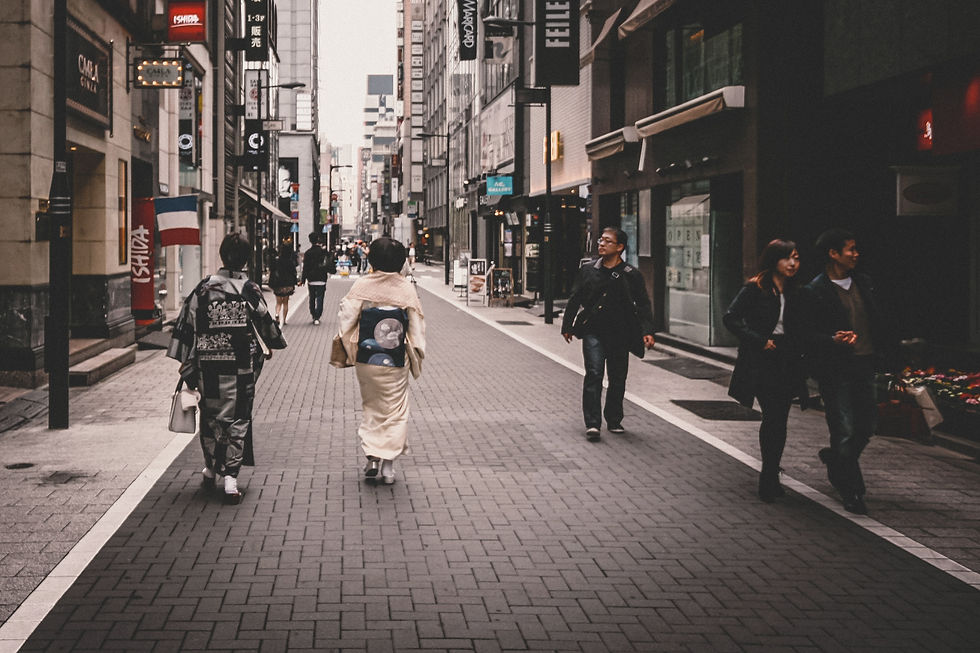
In the colourful scene of Japanese fashion there is an icon of unparalleled elegance and tradition: the Japanese Kimono. Originating in the distant realms of ancient China and evolving into an exquisite form of attire in Japan, the kimono has enthralled hearts across the world. These exquisite pieces of clothing have become an integral part of Japanese culture.
The word "kimono" itself translates to "thing to wear" in Japanese, which hints at its simple yet elegant design. They are usually made of pure silk and utilise unique dying processes, such as yūzen (a resist-dying technique where rice glue is traced along the lines of the design to keep the outline undyed) and shibori (an intricate form of tie-dying that is highly prized in Japan). Artisans also embellish the kimono with intricate wagara (Japanese patters), hand painted motifs, immaculate embroidery, and surihaku (gold & silver foil impressions), often creating scenes referencing seasonal themes.
The earliest predecessor of the kimono can be traced back to the Heian period (794-1192). During this era, craftsmen ingeniously crafted garments by sewing together straight-cut pieces of fabric. These early kimono were renowned for their adaptability, suiting various body shapes with ease and comfort. As the centuries rolled on and the Edo period (1603-1868) came into play, this attire transformed into more elaborate designs to suit a shifting socio-economic position. Over the centuries, the kimono underwent numerous such transformations, reflecting changes in fashion, culture, and society.

Sleeve Lengths: A Tale of Tradition and Transition
One of the distinctive features of kimono are their variation in sleeve length. It's not just a matter of aesthetics but a reflection of the wearer's age, marital status, and the formality of the occasion.

Furisode (振袖):
Furisode are easily recognisable by their long, swinging sleeves. This style is worn by young, unmarried women. It's a formal kimono, and is often adorned with intricate patterns and vibrant colours, making it a popular choice for special occasions like coming-of-age ceremonies. The reason for the long sleeves was to increase air circulation for the wearer and to keep them cool, and gradually came to represent the colourful nature of youth. This style was actually once gender-neutral, and was worn by young school-age boys until the early 19th century when Western influences became stronger.

Hōmongi and Tomesode (訪問着と留袖):
These kimonos usually have medium-length sleeves and are worn by woman in their mid-twenties and upward. That said, tomesode can only be worn by married women while Hōmongi are unrestrictive. The difference between them lies in the patterns; hōmongi boasts more elaborate designs on the sleeves, chest, and the bottom of the kimono, and is considered semi-formal attire. Tomesode, on the other hand, are more pared back and are reserved for more formal situations, like mother of the bride.

Iromuji and Komon (色無地と小紋):
These kimonos feature shorter sleeves and are often worn by women of any age for various casual or semi-formal events. Komon feature a smaller recurring pattern over the entirety of the kimono, while iromuji are unpatterned and can be any colour besides black. (The equivalent of a black iromuji is known as a Mofuku (喪服), which is a mourning outfit and is solely reserved for funerals and all-night wakes.)
The formality of a kimono can also be changed with the addition of kamon (family crests), and a kimono may have one, three, or five crests, with increasing levels of formality. For a kimono with five kamon, they would be placed both sides of the chest, on the centre of the back, as well as on the back of both sleeves.

Male vs. Female Kimono
You can tell the difference between women's kimono and men's kimono by three things, the first of which being the inner seam of their sleeves. If the seam of the inner arm is sewn all the way up under the armpit, then it is a male kimono. In contrast, if it is left with a large unsewn stretch, known as a sodeguchi (袖口, lit. sleeve mouth), then that is a female kimono, as women tuck their arms through these open slits to adjust their kimono when dressing.
Another way to tell the difference between masculine and feminine kimono is by the pattern and the length. Male kimono are usually of darker, more subdued colours, and less flashy patterns. They are also far shorter than female kimono, as women have a more intricate style of dress which involves using excess fabric to create a fold (called an Ohashori, お端折り) which is tucked beneath their obi. This excess of fabric also allows a single kimono to be worn easily by different people of varying heights.

Cultural Significance Today
While kimono have evolved to match contemporary lifestyles, their cultural significance remains undiminished. Today, they serve as a vessel for preserving Japan's rich heritage, and are often donned on special occasions, such as weddings, coming-of-age ceremonies, and festivals, evoking a sense of pride and tradition. There are even specialist kimono dressers who spend years training to learn the art of kimono, mastering even the most complicated of musubi (obi knots).
Japanese kimono have also found their way into the world of fashion and art. Modern designers fuse traditional elements with contemporary styles, creating a bridge between the past and the present. Museums and exhibitions celebrate the craftsmanship behind these exquisite garments, and, in the modern day, they stand as an elegant reminder of the nation's cultural roots and a celebration of its enduring grace. So, whether you're donning a furisode for a special event or a komon for a casual outing, remember that a kimono is more than an outfit; it is a piece of history and a work of art that transcends both tradition and time.








Comments